#I want a game where we can explore the other dimensions freely. can you imagine
Explore tagged Tumblr posts
Text
tpc dropping the coolest group of characters in one pair of games and then doing nothing with them
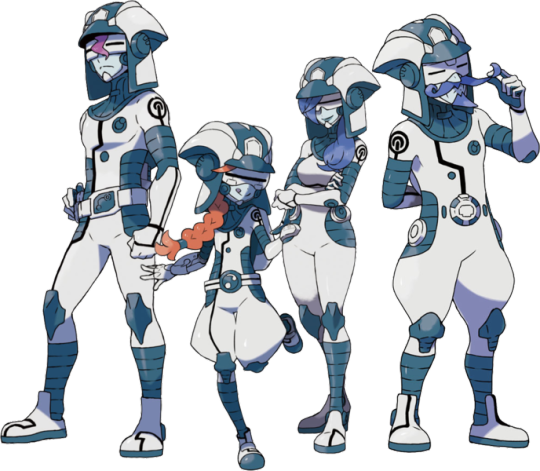
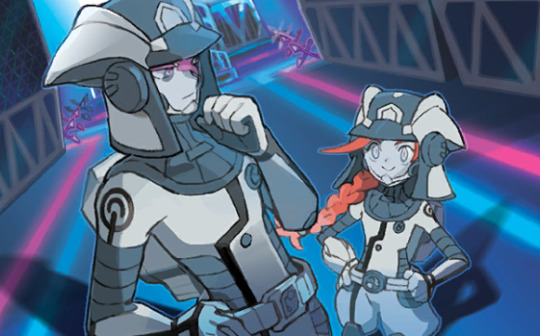
#theyre literally people from another dimension. thats fucking awesome#too bad their dimension is a hallway#I want a game where we can explore the other dimensions freely. can you imagine#just a game focused on going through the wormholes#collecting stuff along the way#i think it'd be fun
131 notes
·
View notes
Text
Digital Disguise: The Impact of Change Face Technology on Social Networking
In the ever-evolving world of social media, making a connection can sometimes feel like navigating through a digital maze. What if I told you that tools like Change Face are quietly revolutionizing the way we interact online, offering a bridge across the social divides we face? Imagine stepping into the virtual world not just as yourself, but as anyone you choose. This isn't just about fun; it's about the profound effect of personal expression on social networking.

The rise of Change Face, particularly with platforms like PPnude, is more than just a fleeting trend. It's a reflection of our human desire to connect, to express, and sometimes, to change. According to a recent survey, over 70% of social media users have engaged with some form of digital customization, and the numbers are growing. Change Face isn't just about swapping faces in photos; it's about crafting a new persona that can break the ice, foster a connection, or simply offer a fresh perspective.
Let's dive into how PPnude's AI Face Swap tool is becoming a game-changer in the social media realm. The technology itself is fascinating; leveraging neural networks to seamlessly swap faces, it allows users to create custom avatars that can represent them in online spaces. But what does this mean for social interactions?
For starters, it democratizes the concept of identity. In a digital world where first impressions are often formed based on a profile picture, the ability to present a different face can level the playing field. This is particularly powerful for individuals who may feel constrained by their physical appearance or those who want to explore different aspects of their identity without judgment.
Consider this: a study found that users with customized avatars report feeling more comfortable and confident when engaging with others online. This confidence isn't just about aesthetics; it's about feeling empowered to express oneself freely. Change Face technology gives users the tools to present their best self, or perhaps, a self they aspire to be.
Moreover, the implications for online communities are significant. By enabling users to create and swap faces, platforms like PPnude are fostering a sense of inclusivity that can be hard to achieve in the standard, static avatar paradigm. This flexibility can encourage more diverse interactions and can help build communities that are less superficial and more about the content and ideas being shared.
But let's talk numbers for a moment. The average user spends nearly two hours on social media daily. That's a significant chunk of time where personal expression can either be limited or expanded. By integrating Change Face technology, platforms are providing a richer, more engaging experience that can translate into increased user satisfaction and retention.
Now, you might be wondering, isn't this just about superficial changes? What does it really contribute to meaningful interactions? Well, consider the role of anonymity in social media. While it can sometimes lead to negative behavior, it also offers a shield for those who might otherwise be too anxious or afraid to engage. Change Face provides a similar layer of protection, allowing individuals to participate more fully without the fear of judgment or harassment.
Of course, with great power comes great responsibility. The NSFW mode in PPnude's AI Face Swap tool, which allows for more adult-oriented face swaps, needs to be used judiciously. It's a feature that must be handled with care, ensuring that it doesn't become a tool for misuse or harm. But when used appropriately, it can be another dimension of self-expression that adds depth to our digital interactions.
Finally, the advent of Change Face technology, particularly through platforms like PPnude, represents a significant change in how we approach social networking. It's not just about changing faces; it's about changing the way we connect, the way we express ourselves, and the way we engage with others. As we continue to guide the digital landscape, tools like these remind us that our online personas can be as fluid and dynamic as we choose to make them. So, are you ready to put on a new face and see where it takes you in the world of social media?
0 notes
Text
Volume 1 Prologue
Virtual Reality.
The ever sought after paradise for everyone who loves video games.
The first virtual reality developments came in the beginning of the century, but they were all based on external hardware. Awkward remotes and gloves, bulky goggles. The hardware became smaller, sleeker, more immersive over time. But in the end, all they were was an entertaining trick — limited by what it could show and who could even physically use it.
They brought the player closer to the screen then ever before. But they could never bridge the gap between the real world and the game. The true holy grail of gaming would lie in fully immersive virtual reality; that would take you to the very edge of the screen, and then pull you inside. To wake up inside your favorite game, whenever you wanted. It was the dream that could never be.
And then came the Digital Mind Project.
A private think tank based in the city of Seattle. They gathered the world’s best programers, neurologists, biologists, and psychologists. After working for over a decade, they did it. They mapped and named every possible neural pathway in the human brain and explained it’s function. They created the first complete, digital model of the mind, and it could think like one.
Overnight, the processing speed of all technology in the world skyrocketed. Data could be processed faster and more efficiently then ever imagined. Brain diseases that seemed incurable now had mapped explanations and accessible cures.
The digital and physical revolution that resulted led some people to question where the limit really was. If you can put the human mind in a machine, couldn’t it work the other way around?
Countries, governments, armies, corporations — they all fought to develop and control this untouched potential. But the leaders of the Digital Mind Project had decided to join the race, and, just like before, they won. They developed a full scanning pod, that only required a user to sit in it. The pod would sync to the electric signals of the nerves pathways and, upon triggering sleep, allowed the person to fully connect to the machine.
They sold the design for the pods to every business that could afford it, all at the same time. In the middle of the 21st century the age of Virtual Reality had truly begun.
The first games to come out were… disappointing, to say the least. Barely more then tech demos. Allowing the player to get a unique experience but hardly qualifying as a true game. A rushed attempt at formatting a classic MMORPG as the VR game, Fields of Fighting, was a disaster. It was riddled with horribly coded AI, clunky, unnatural movements, invisible walls everywhere that could physically trap players by accident. It was unplayable.
All the technology you could ever need for VR was available, but game designers were struggling to catch up. They had to learn to think and create in a whole new dimension. The old techniques wouldn’t cut it.
That learning curve led to a drought in Full VR games. Most companies stuck to their tried and true dimension of game design, and if people were lucky they might see a halfway decent Full VR game release once or twice a year.
Then, without any warning, two of the biggest games to hit the market were released in the same year.
The first was a sprawling, open world RPG called, Record of the Ancients. Set in the fantasy genre, this was a single player game that offered its players absolute freedom of choice to explore the world and affect it however they wanted. The game held its own share of bugs and the occasional empty plain or lack of detail, but there was nothing else like it.
The second game was a massive multiplayer sci-fi battle called, Solar Forge. Players could freely participate in large scale, solar system spanning battles. Anything from piloting a ship, to organizing a galactic cruiser, to dropping into and storming an enemy vessel with your squad. Two teams ranging anywhere from 50 to 300 participants all fighting a space war to decide a victor. The largest scale fights could even span days, and a lot of people became addicted to acting as a space marine.
These two games sold more then anyone dared to dream, proving just how unique Full VR gaming could really be. They also set the trend for how these games would be approached. Either broad, if shallow, experiences in a large environment or the chance for rich world building but in a very narrow and strict environment. No one would even attempt to make up for the failed promises made by the flopped Fields of Fighting experience.
Things stayed this way for over a decade. New games came and fell, but Record of the Ancients and Solar Forge remained on top.
One day, without any big press releases or industry fanfare, a new game started putting up commercials and advertisement. It promised to revolutionize Full VR and offer an experience greater then any of it’s predecessors. Deeper, more detailed worlds. No restrictions on player freedom. An MMORPG that could support millions of players across the world, all at the same time.
These claims were so preposterously huge that no one believed it. Especially because they were being made by a brand new games company called Aurum Productions, that no one had even heard of before.
But the ads kept coming.
And once people started looking into the game, and more specifically, Aurum Productions, they learned that this new game had some shocking secret weapons going for it. The founder of Aurum Productions was a man named Mike Wirth, one of the former lead programers of the Digital Mind Project. He had brought a gift for this new game: a new piece of technology called, Player Perception Tuning (PPT).
In order to allow the most robust, flexible, and realistic experience possible a machine alone couldn’t cut it. Instead, PPT allows the players own brain, already synced with their pod, to process the game’s data for them on the spot.
Instead of having to code every aspect of the game to recreate reality, they instead offer the brain a very convincing framework of reality, and allow the individual brain to fill in all the pieces. Instead of realism, the programers were going for impressionism.
What they got was more realistic then any game ever made before it.
Since every player was acting as their own processor, it made it much easier to have everyone play at once. Since they only had to design the framework, the game team at Aurum had that much more freedom to create a real, enriched world.
In the summer of the year 2076, the groundbreaking Full VR, fantasy MMORPG, Golden Age, released.
__________________________________
In the void of space, above an endless fog, floats an island of gold and riches. There are artifacts, weapons, and sculptures — all crafted from precious metals and rare gems. Priceless artworks and fine clothing are lazily scattered about. The ground is made up of gold bars and golden coins. They drip from the bottom of the island into the void of the fog, but the island never grows smaller.
At the center of the island, purple strands of energy gather together to construct a humanoid wireframe.
From nowhere and everywhere at once, the Overvoice of the game speaks.
Hello, would you like to customize your character, or would you like a randomly generated one?
A voice from the wireframe responds.
“I’d like to customize.”
Very well.
From all over the island, wisps of light gather together to form a giant ball of light in front of the wireframe.
First, please select what race you would like your character to be. You can chose from Human, Dwarf, Orc, or Elf. You may also choose a ratio, of two of the previously mentioned.
“Human.”
Very well.
Some of the light gets shaved away, scattering into space. The ball of light has now roughly taken the size and shape of a human.
Please select what sex you would like your character to be.
“Um, I’ll take male for me.”
Very well.
Barely any light is shaved away but the figure of light now resembles a blank human male.
Please select your body type.
“How about we go with svelte but athletic. Like a martial artist kind of build, maybe?”
Very well.
This time, more light is shaved away and the figure now resembles a fit, athletic human man.
Would you like to move on to face sculpting, body sculpting, or voice sculpting next?
“You know what, just have everything else look like my real body.”
Very well.
Light flew away from the human figure in spirals of light until everything burst out. In the place of the light was a tan skinned, human man. The body was still athletic, decently tall, had long sideburns, stubble on it’s chin, gray eyes, and streaks of gray hair at the temples and the front. It had on a set of cotton pants and a cotton shirt, tied down by a coarse rope, and simple leather shoes. The body stared lifelessly at the wireframe in front of it.
In front of the wireframe, a hologram of a keyboard appeared.
Please spell the name of your character.
The wireframe reached out with a hand and pressed: D, 0, n. And hit enter.
Please pronounce how to say the name of your character.
“You pronounce it like you would for an Italian mob boss. Or like the dawn of a new day.”
Very well. Please step forward into your character to initiate syncing.
The wireframe took clumsy steps towards the human body in front of it. On contact, the purple lines of energy that made up the wireframe fused into the human body.
I could suddenly feel everything. The clothes against my skin. The shifting, hard coins that made up the ground under my feet. The cool breeze that started to blow across my face.
In front of my eyes I could see that the endless sky of space, littered with stars and streaks of purple throughout. Streams of the gold coins that made up the island were flowing off the edges. They were dispersing the fog.
In front of the island was a floating circular flat world. Absolutely huge, it took up my whole vision. There were three distinct continents in the center of the wide ocean.
The one on the left was made of sweeping mountain ranges and floating islands, that looked like they were made of gemstones.
The one on the bottom was a giant archipelago, made up of countless, rich islands.
The one on the right had sprawling green fields and verdant forests and crystal blue lakes.
The edge of the world had a misty, thick fog all around it, but I could see waterfalls flowing into the void of space underneath. The sun was bright and lit up everything beautifully. I could hear rising orchestral music playing from somewhere. From nowhere and everywhere at once, the Overvoice of the game spoke to me.
Welcome, to the world of Golden Age, D0n.
I felt like I could stare at that sight forever.
But I didn’t have that chance. Suddenly the ground began to rumble under my feet. The streams of gold flowing off the side rushed forward, and huge swaths of the island began to break off.
Eventually, the whole island destabilized, falling to the planet below. I went with it. As I was falling among columns of gold and treasure, I heard the Overvoice again.
Due to your region of origin, you will be starting in the Plains Continent. Below, you will enter the Tutorial Village. There, we have provided class instructors, resources, and all the knowledge you will need to explore the game. Have fun.
The ground was getting closer and closer. I could no longer see the edge of the world. Below me was an impossibly thick cloud.
All of the gold around me started to dissolve into particles of light.
I was in the middle of an uncontrollable free fall. The wind was rushing past me so fast it was whipping at my clothes and shoving my hair away. My eyes were tearing up from the force of it.
I felt a wide smile, that showed all my teeth, spread across my face.
It was time to play the game.
3 notes
·
View notes
Note
What are you hoping for from a new Paper Mario? What's your "golden ideal", I guess?
I could spend, like, years thinking of things I’d like to see in a Paper Mario game, but I’ll try to narrow it down. Here are some of the main things I’d really like to see:
☆ New partners (plural)
• Based on previously established Mario species, preferably “enemy” species, as “The circumstances of one’s birth are irrelevant; it is what you do with the gift of life that determines who you are.”
• Unusual, but believable, and perhaps even poignant, backstories and fully realized character arcs. I want to care about these characters because I’m invested in this world, its inhabitants, and those inhabitants’ personal successes and failures, not just because their design is so kawaii and/or their dialogue is so funny, though those things are a plus.
• Distinct personalities and opportunities to show those personalities off (through design, body language, dialogue, etc).
☆ RPG mechanics
• Built on the solid foundation established in Paper Mario (N64)
• Turn-based combat
• A leveling system where you get to choose which stat to increase
• Badges (Including superficial badges like the L Emblem and Attack FX badges)
• Something new, like being able to use two partners to perform a Bros.-Attack-like move, or maybe even stats specifically pertaining to your partners.
☆ New locations
• It’s a delicate balance. Locations should both feel like they could realistically exist in Mario’s world and feel like something we’ve never seen before. TTYD has some great examples of this (Rogueport, Boggly Woods, Twilight Town, etc). Super Paper Mario has some creative locations as well, but because it takes place in another dimension, not in the typical world that Mario inhabits, none of them really feel particularly “Mario-esque” in nature. They’re all a bit off-brand, so to speak.
• On a technical level, graphics are improving all of the time, but that doesn’t automatically lead to more intriguing and/or more visually satisfying designs. At it’s core, Mario is a fantasy franchise, an escape from reality, and the Paper Mario series is one of the few series in the franchise that really builds out- or at least used to really build out- its world, and that world was interesting because it was new and mysterious, it practically begged to be explored. Paper Mario games should show me something I can’t see in reality; I know what paper and cardboard and lemons and steaks look like, show me underground cities and palaces, show me sprawling gardens with talking flowers, show me a floating tourist trap in the sky. The biggest limit is your imagination, so let it run wild, and show me that, show me that Alice in Wonderland-like controlled chaos.
☆ An interconnected world and motivated backtracking
• No stage-selection maps. Even if the game is fairly linear, I don’t need to have that shoved in my face. I don’t want to feel like I’m working my way down a to-do list, glued to a track, I want to journey through the world and explore somewhat freely.
• No fast travel by default (maybe you unlock fast travel after beating an optional challenge like the Pit of 100 Trials)
• No pipes that take you right from the hub world to the chapter area; I wanna walk…
…and I want it to be through a believable, expansive, intricate world that changes as I progress through the game, a world I could see hundreds of times and never get sick of because its details are constantly in flux, and because those details are the kind that make it feel realistic and lived-in. I don’t want to be teleported from A to B, or confined on a path from A to B to C, I want to explore, I want to discover, I want to experience this world and to form an attachment to it. This alone would make backtracking more worthwhile, but…
• …another way to make backtracking even more enjoyable would be to add events that make walking into a game in and of itself, like having to follow a creature up in the trees, or having to get through a cursed area in Mirror Mode, or having to dodge and weave through falling rocks because there’s a huge earthquake destroying- and altering the actual geometry of- the area. Walking doesn’t have to be a chore for you to complete in order to get on with the game, and it shouldn’t be, it should be part of the game, just as engaging as anything else you’re involved in.
☆ Non-linear elements
• The game should still be fairly linear overall, because Paper Mario games are chapter-based stories with beginnings, middles, and ends, but having some say in which chapter comes next, or which partner you meet, or even just which puzzle you solve next would give the player a stronger sense of agency. Story-driven games are at high-risk of making the player feel like they’re just along for the ride, and this would help to counteract that.
☆ Spin dashing
• Gotta go fast! Getting rid of spin dashing always felt like an odd choice to me. Characters like the Yoshi kid, Carrie, and Dashell kind of replaced it, in the sense that they allow you to move quickly, but being able to speed up without switching partners, as well as being able to spin attack and just to witness the utter chaos of Mario flinging himself across the screen again, would make backtracking and walking around in general less of a slog. It would also give you more agency in the overworld and serve as a nice callback to the original game.
☆ Free-moving NPCs & situational dialogue
• In past games, NPCs have been confined to certain paths and locations. They might move from chapter to chapter, but they would always stay in the same general area until you triggered an event that placed them somewhere new. I’d like to see characters wandering around, going in and out of buildings, visiting other locations, having private conversations with one another, getting into fights, buying and selling items at the shop, putting on different clothes, and doing just about anything else they would typically do in-universe. Obviously this would be huge challenge to program, but we’re talking about an ideal here, and anything in this general direction would be an improvement in my eyes. We already see a bit of this in the series, but I’d like to see even more.
• When NPCs say things like “Where are your manners, Mario? You shouldn’t climb on the table” and “Don’t be so careless. There are too many enjoyable things in the world to gamble with your life!” it makes it feel like they actually see what you’re doing and care about what you’re doing. Having NPCs respond to you differently because of where you’re standing, or what partner you have out, or what badges you’re wearing, and so on, makes them into more than just set decoration or a sign to read, it makes them people, or at least more person-like. Nintendo’s been pretty good about this in recent years, probably because technical improvements have made it easier than ever before, and I think it would be fitting for a series known for its world-building.
☆ Dynamic lighting design & a day/night system
• This is all about aesthetics because, as it turns out, visuals are pretty important in a video game. Paper Mario (N64) had some really interesting lighting design, notably in darker areas like the secret passage in Peach’s castle, and we haven’t really seen a lot of that since, despite having more advanced technology that would allow for advanced lighting.
• I’d like to see things like swinging chandeliers that cast beams of light, and cracks in the ceiling that light pours through, and mirrors/reflections that Mario uses to solve puzzles, and shadows that hint at secrets. Lighting is a huge part of shaping a world, and using it in a variety of different and meaningful ways just makes your world seem that much more complex and grounded.
• As for the day/night system, I am picturing a game that visually changes based on the actual time of day, kind of like Animal Crossing games do, but not a game that requires it to be a certain time of day for any gameplay purposes, not for the main quest, not for side-quests, and not even for easter eggs. All I want is for it to be bright when I play in the morning, orange when I play at sunset, and starry when I play at night. This also would add to the game’s replayability, as different chapters would look and feel different depending on what time of day it was when you played through them.
☆ Easter eggs that reference other games in the franchise
• I want it to be clear, beyond a shadow of a doubt, that the Mario we see in Paper Mario games is the same Mario we see in other Mario games, not another person, and talking about the time he visited Isle Delfino or when Bowser fused with a sentient tennis racket would really drive that home.
• Make me really look for some, though. It’s cool to spot easter eggs in plain sight, but what’s really rewarding is having to dig for them. I don’t just wanna see Luigi standing in the background, I want to spot little inconsistencies and cracks in the walls and cryptograms spread throughout the world. Sure, the five-year-olds playing might not find them on their first playthrough, but when they’re fifteen and they remember that awesome Paper Mario game they played a decade ago, they won’t just be revisiting a world they’ve fully explored, they’ll be playing on a whole new level, figuratively speaking.
☆ amiibo Compatibility/functionality
• I’m not a big fan of DLC in general, as it’s often overpriced, but I do think amiibos are neat; using a real object to unlock something in a virtual world makes the virtual world feel just that much more alive to me, that much more like it’s a little world I can actually affect.
• The Paper Mario series never really got official merch, and while you do see a bit of your partners’ lives in the epilogue, it’s only a glimpse into their future, so getting little figurines of past partners that make them appear in the game, tell you about a recent adventure they had, and give you a unique badge based on their abilities/personalities/experiences, would be like a dream come true.
☆ Just be creative (I know it’s not that simple, but like, figure it out)
• Surprise me; throw in something inventive and revolutionary, like Wall Merging from A Link Between Worlds or The Aperture Science Handheld Portal Device from Portal. There’s a whole universe of possibilities out there; please dream a little bigger than items disguised as a gameplay element and a hammer that fills in glaringly obvious gaps in paint. Nintendo’s always pushing the video game industry forward with their creative consoles. Use that, take whatever whacky control method they come up with next and integrate it like Super Paper Mario did- but hopefully even better than Super Paper Mario did- with the Wii remote.
• I see fans writing stories, and drawing characters, and making sprites, and working with all kinds of mediums to make art that knocks everything from recent “Paper Mario” games out of the park. Obviously Intelligent Systems can’t just steal those ideas, but I’d love to see them get on that wavelength and match that passion.
• Make a game that you’d never want to put down because you just can’t get enough of it, and don’t even bother with that “You’ve been playing for a while. You wanna take a break, grab a snack, chill out for a sec?” message; if I die playing your game because it’s truly that good, I see that as an absolute win. That’s legendary game design, my friend; aim to make a Paper Mario game so good it’s worth dying for, and if you fall short of that, hopefully you’ll still land on something pretty awesome.
185 notes
·
View notes
Text
Dragon Ball Z 168
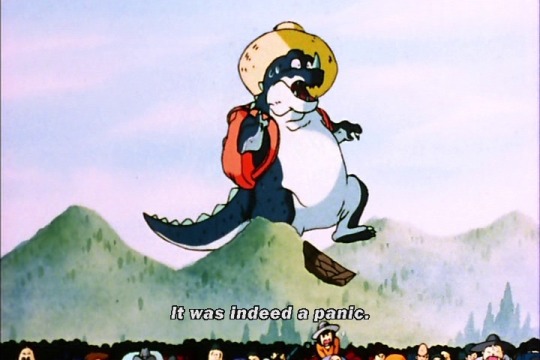
The announcement of the Cell Games has sent the entire world into a panic. Even these giant dinosaurs are fleeing in terror. What I don’t understand is where everyone thinks they can run to. Cell said he was going to kill them all.

Oolong proposes they use the spaceship at Bulma’s house to flee into outer space. Fuck you, Oolong.
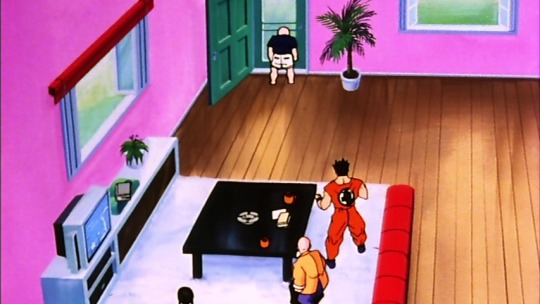
Downstairs, Krillin flips out and tries to rush out to fight Cell right now, because he feels so guilty about allowing Cell to become perfect. Yeah! We don’t need to wait nine days! Let’s have the Cell Games TONIGHT.
But Master Roshi forbids him to throw his life away on a battle he can’t win. Instead, he tells him to wait for the Cell Games if he intends to fight at all. I like the way this scene is written. We all know Krillin doesn’t have a chance, because he already fought Perfect Cell and couldn’t do anything to him. But Krilin feels like he has to die trying because this is the only way for him to atone for his mistake. And Roshi gets that, even if he doesn’t agree, so his compromise is to ask Krillin to wait ten days before restoring his honor, when he’ll have the best possible chance of surviving the effort.

By contrast, I think Yamcha’s already accepted that he just can’t participate in this battle. He’s gonna go, and maybe help if he can, but after he saw Cell blow up that town after his announcement, Yamcha knows he’s out of his league. Krilln knows it too, but for him, not fighting Cell isn’t an option. He can’t live in this world knowing he has to share it with the monster who swallowed 18.
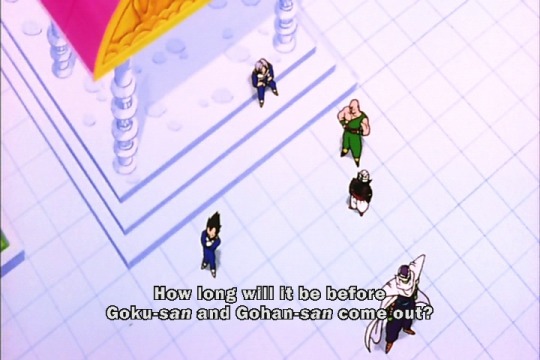
Up on Kami’s Lookout, everyone is waiting in line for the next turn in the Hyperbolic Time Chamber. Well, not Tien, since he doesn’t think a year in the chamber will do him enough good to beat Cell. I think he just hasn’t left this place since Goku brought him here the day before. But Piccolo plans to use the HTC, and Vegeta and Trunks plan to go in again.
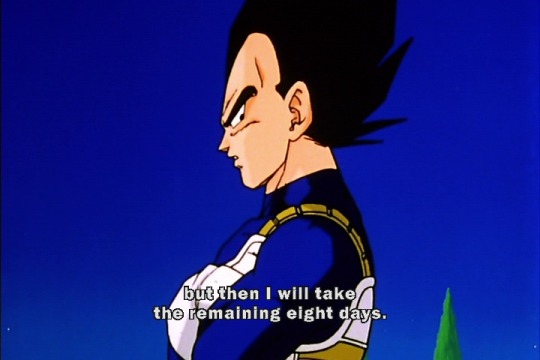

Vegeta agrees to let Piccolo have the next turn, but then he wants the remaining eight days for himself. That sounds like a pretty good idea. One day in the chamber was enough for Vegeta to leapfrog the androids and Semiperfect Cell, so imagine how much stronger he’d be if he trained for eight more years. The problem is that you can’t spend that much time in the chamber. After 48 hours, the door vanishes, and you can never return to Earth.
So let’s talk about that for a minute, because Dragon Ball Super really ignored that rule. I think Goku and Vegeta used the HTC on at least three separate occasions in that show, even though Vegeta used up all of his 48 hours in this arc. To be fair, the Fusion Saga demonstrated that it was possible to escape the HTC dimension without a door, so maybe that was how Vegeta got around it. Still, I think it kind of sucks a lot of value out of the concept when you can just re-use it as often as you please. As much as Vegeta used the chamber in DBS, he never seemed to get that much stronger. Also, it’s just kind of shitty to have the main characters cheat an extra year of training in whenever they get in over their heads. I’m pretty sure that’s why Toriyama invented this 48 hour limit in the first place.
So why did he introduce the chamber at all then? I feel like it works in the Cell Sagas because it serves as a secret weapon the Z-Fighters can use to counter all of Cell’s secret advantages. This whole conflict has been about superior intel. Gero spied on Goku for years, hoping to collect enough data to design a superior warrior. To that end, his plan depended upon his ability to project how strong Goku would be at a certain point in the future. But Goku turned Super Saiyan on Namek, and Gero had no idea. Goku also got a warning from Future Trunks, so Gero’s projections were further thrown out of whack. But Gero had reinforcements, and that surprised Goku’s team. So Goku busts out the Time Chamber as a way to close the gap. By training in there, where time moves at a different pace, they could power up beyond what Dr. Gero could have anticipated. That’s why it works in this story. It levels the playing field.
In the Buu Sagas, they only reintroduce the Time Chamber to illustrate that it won’t be very helpful this time around. But Dragon Ball Super never worried about whether a gimmick actually helps a story. They just used the Time Chamber so they could reference the DBZ episodes that used the Time Chamber. It was never about telling a story there, it was about reminding fans of something they already knew about.
The bigger question I have is how the 48-hour rule works. Let’s say Piccolo and Vegeta go in the Time Chamber together. Vegeta’s already used it for 25 hours, while I assume Piccolo has never been in there before. So after 23 hours, are they both trapped inside? Is there some magic where Piccolo can use the door but Vegeta can’t? And how is that reflected in the outside world? Could Goku not enter the chamber after Vegeta maxed out his alotted time?
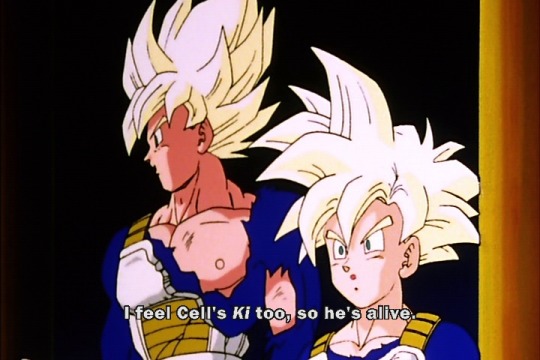
Anyway, Goku and Gohan finally come out, and they’re actually a few hours early. They sense Cell, Vegeta, and Trunks are all still alive, so they wonder what’s been going on. But before they get a recap, Goku needs to take care of something important first............................................
.........................................................................................................................................................................................................................................................................................................................................................................................................................................................................................................................................................Goku really needs to eat something first, you guys! BWAH? The whole world’s in danger and all he can think about is foooooood? What’s with this guy? What a hilarious and unexpected thing for a hero to say, it’s very clever. No, this gag hasn’t been run into the ground.

It’s not that I have a problem with Goku eating a bunch. It’s actually very relaxing to watch him eat. The sound effects are just very, very soothing. All the dishes clinking, the piles of rice, the stacks of bowls. I just don’t like how they keep making a joke of this. As Goku explains, they had food in the chamber, but Mr. Popo’s a better cook than either of them, so this is a better experience. Is that so wrong?

Oh, incidentally, they’ve been in Super Saiyan mode the entire time, and Vegeta wonders how and why they managed to do this. Up to now, it would be very taxing for a Super Saiyan to just hold the form for long periods of time, and they’d be too restless to sit down for a leisurely meal.

Meanwhile, more panicky Earthlings are trying to flee the cities. The one little girl is on a train, and she starts getting excited about something she sees out the window. Her mom wonders what it is...

It’s Cell.
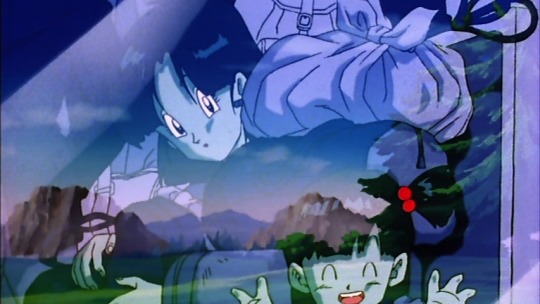
Yeah, me too, kid. Cell’s awesome.

Fortunately for the train passengers, Cell doesn’t bother with them, but the line of cars waiting at the railroad crossing. He chucks a car into the traffic just to be a dick.

And it explodes, because anime. This episode actually has two exploding cars in it, which is kind of nuts when you think about it.

This is from earlier in the episode, but this guy just drove into an alley and hit another driver who had the same idea. I guess they both had a crate of dynamite in their back seats?

Back at Capsule Corp, Bulma’s taking a look at Android 16′s programming, and the code documentation has an awesome picture of Super Saiyan Goku punching Frieza. Pretty sure that shouldn’t be in 16′s memory banks, seeing as how Gero never had any spy robots on Namek to record that moment.
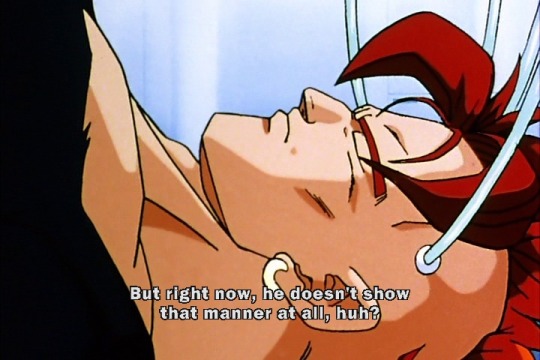
The big irony is that 16 has no human parts at all, so he was created with nothing else but a program that boils down to “10 Kill Son Goku, 20 Goto 10″, and yet somehow he made the leap to defending the other androids from Cell, and befriending small animals like birds and Krillin. The best thing is that DBZ still has a long way to go, so we’ll have plenty of episodes to explore the emergence of 16′s soul, and what that says about the nature of artificial intelligence. Right? You’re shaking your head, why are you doing that?

Back at the Lookout, Goku seems interested in the Cell Games idea. I mean, he was expecting to fight Cell anyway, or possibly Vegeta if he ended up winning, so all Cell has really done is set a date for the battle.

Popo gives Goku his classic outfit, and Trunks is all “You don’t have to wear that.” and Goku’s like “I get to wear this, Trunks.”

As for Gohan, he asks Piccolo to give him new clothes resembling Piccolo’s outfit, since he first trained under him. One Clothes Beam later...
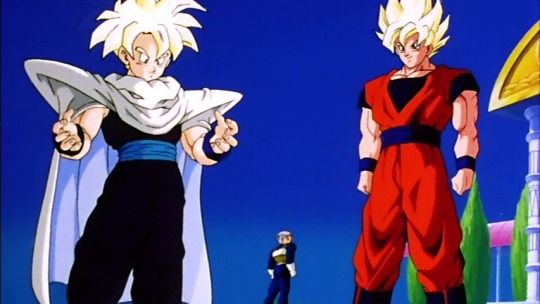
Fuck yeah. It’s time for the Cell Games Saga, dammit. No more of this bowl cut Gohan. No more cosplaying as Vegeta. It’s time to rock and roll.

Vegeta ask Goku if he thinks he can beat Cell, but Goku hasn’t seen him in Perfect Form yet, so he decides to check him out. So he just teleports straight to him and they have a talk.
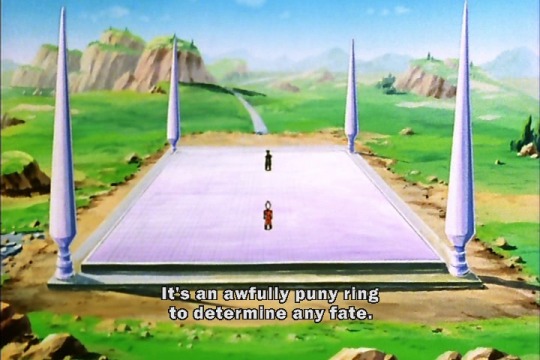
Goku’s not too impressed with the ring, or maybe it’s more accurate to say that he doesn’t find it all that impressive that Cell believes it will decide the fate of the world. For as much as Goku enjoys battle, he doesn’t see it as something more than what it is. He just wants to mix it up with Cell. If that’s a friendly match or a fight to the death, or the lynchpin to the safety of the cosmos, that’s beside the point.
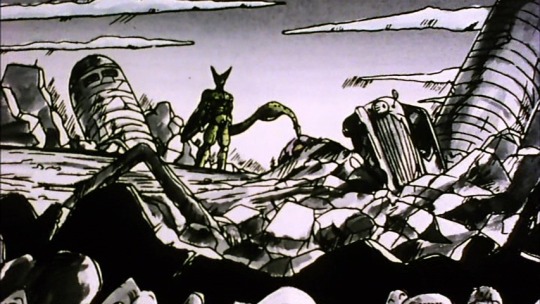

Goku asks him about his perfect form, and there’s this cool black and white montage of Cell’s life story. It’s pretty sweet.

Anyway, Goku tells him not to kill anyone until the fight. Cell doesn’t actually agree to that, but what’s Goku going to do about it?

So Goku teleports back, and he freely admits that Cell’s a lot stronger than he expected, and that Celll would probably win if they fought. Well, that’s no big deal, because they still have several days to prepare, so Goku can just go back in the Hyperbolic Time Chamber for another year.
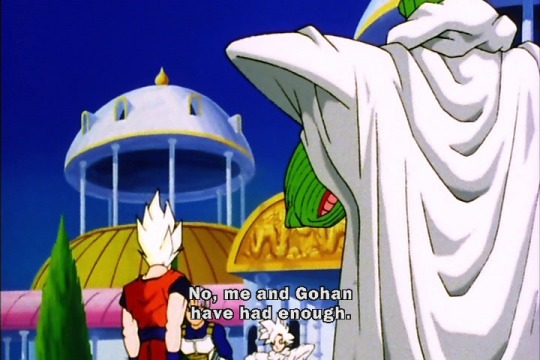
But Goku declines. As far as he’s concerned, he and Gohan are all finished training in the chamber. I guess that figures, since they came out early.

And that sets up the big question for this arc. If Goku believes Cell is stronger than himself, why is he so relaxed about this upcoming battle? Why won’t he train to close the gap? What does he know that no one else does?
#dragon ball#2019dbliveblog#cell games saga#goku#gohan#vegeta#trunks#cell#perfect cell#oolong#puar#chiaotzu#piccolo#tien#android 16#yamcha#master roshi#mr popo#android 18#frieza#well in flashbacks anyway
17 notes
·
View notes
Text
Alice Madness Returns Demo Download

RSS Feed for this tag 36 applications totalLast updated: Nov 26th 2018, 13:27 GMT
Alice Madness Returns Demo Download Torrent
Alice Madness Returns Demo Download Full
Alice Madness Returns Demo Download
Alice Madness Returns Demo Download Windows 7
Alice Madness Returns demo download download Alice Madness Returns full version pc game Patch. Browse more videos. Misfortune Ramirez Hernandez, an imaginative 8-year-old, seeks the prize of Eternal Happiness, as a gift to her Mommy. Led by her new friend, Mr. Voice, they venture into the woods, where mysteries are unraveled and a little bit of bad luck unfolds.Little Misfortune is an interactive story, focused on exploration and characters, both sweet and dark, where your choices have consequences. Purchase American McGee’s Alice™ today, or download it for free as part of your Online Pass, and experience where the madness began! Play through the cult classic and relive Alice's battle against the Queen of Hearts as she fights to regain control of her Wonderland. Alice: Madness Returns required to play.
Return To Castle Wolfenstein: Enemy Territory
Experience the multiplayer excitement with this new first person shooter. Remember to have fun!
Giana's Return 1.10
Save your sister and get back the magic ruby in this nice arcade game!
The Visitor Returns 1.3
A gruesome point and click adventure game where you have to help an alien slug grow
Alice: Madness Returns +13 Trainer for 1.0
Grab the newest +13 trainer for the gameAlice: Madness Returns that gives infinite health
Wizard Of Wor Returns 1.0
Relive the thrills of classic arcade gaming with the new Wizard Of Wor Returns game.
Operation Return Gifts 1.01
Collect presents and save Christmas in this arcade platformer
The Return of Monte Cristo
This is a great hidden object game that follows the story of Edmond Dantes also known as The Count..
Return of Warrior Client 1.1.1.0
Check out a new online multiplayer RPG game where you can create your own warrior and explore an i..
Mystery Case Files: Return to Ravenhearst Strategy Guide
Find out how you can finish the game by solving every puzzle and mini-game
Alice: Madness Returns +1 Trainer
Check out the new Alice: Madness Returns +1 Trainer
Star Trek: Elite Force 2 Addon - Return of The Empty Crown Menu
This is the Return of The Empty Crown Menu addon for the game Star Trek: Elite Force 2
Other
Return to Castle Wolfenstein +5 Trainer
This is a +5 trainer for the Return to Castle Wolfenstein game
Goomba Mario Goombas Return
Here is a new Mario Goomba adventure where you need to fight a pretty difficult boss.
Arcade
Cave of no Return
Try to escape this dreadful cave in a fun arcade game
World of Tanks
Take part in intense large scale tank on tank battles while in control of one of the mighty machines
Lost Constellation
An excellently crafted game that takes you on an short adventure through a strange forest
GOG Galaxy
Keep up to date with the latest GOG.com offers, purchase, install and play games all from this client
Dota 2
Choose a hero and start fighting to the death in this unique multiplayer online battle arena game
League of Legends Client
A world class MOBA that won half of the world over with its characters and intense fights
Team Fortress 2
Valve's humor packed first-person tactical shooter that comes at you with with everything you can possibly want, even hats
Heroes of the Storm
Another one of Blizzard's grand creations, their Hero Brawler which fuses characters from Diablo, Warcraft and StarCraft
Gwent: The Witcher Card Game
Pick a faction and build your deck in this Witcher-inspired CCG with gorgeous artwork and engaging gameplay
World of Warships Online Client
A game that pitches you right in the middle of some very intense naval battles of epic proportions
Rising Thunder
Robot versus robot the way it's meant to be. Bad-ass fighters, excellent graphics, and smooth gameoplay
Dirty Bomb
A lightning fast first-person shooter that puts focus on co-op teamplay and accurate shooting
Warframe
Join the war and defeat the vast armies of the Grineer in this awesome F2P co-op third-person shooter.
Unity
Create anything from small school projects to triple-A video games with the help of this powerful 3D engine and editor rolled into one
Gwent: The Witcher Card Game
Gwent: The Witcher Card Game
World of Warships Online Client
Rising Thunder
Dirty Bomb
Warframe
Unity
World of Tanks
Lost Constellation
GOG Galaxy
Dota 2
League of Legends Client
Team Fortress 2
Heroes of the Storm
essentials
Wolfenstein 3D 2 return of Hitler
Play a fun remake after the classic Wolfenstein, that everyone will surely enjoy.
Arcade
Shotgun FunFun 2: The Return of Buck Morris
Your main objective is to shoot all the zombies as survive for as long as you can.
Return of Oscuro
Check out a an adventure game for children of all ages.
Verbace pro license. Use VerbAce-Pro License Dialog to enter your license details. To open the dialog, click the Menu button and select Enter License. License Code: enter the code you received when purchasing the license (e.g. Abcd1234xyz) User Name: enter the user name your license is registered to (e.g. Verbace-pro License Key Your computer will be at risk getting infected with spyware, adware, viruses, worms, trojan horses, dialers, etc while you are searching and browsing these illegal sites which distribute a so called keygen, key generator, pirate key, serial number, warez full version or crack for VerbAce-Pro 2.5.2. Hack weapon diablo 3. VerbAce-Pro for Windows - Lifetime License. Get a license code now for VerbAce-Pro on Windows and enjoy VerbAce-Pro English-Arabic dictionary without limits! Once you have completed the purchase, you will receive an email with the license code details. Enter the code in the License. License and Delivery. You can use VerbAce-Pro under the following license types: Free Trial: Use the full version of VerbAce-Pro freely for a trial period. Lifetime License: Enjoy VerbAce-Pro without time limit. The license is delivered immediately after payment confirmation via email.
Action/Adventure
Return to the Shadows 1.2
Fly around and shoot all your enemies in this arcade game!
Ship Simulator will make all your dreams of becoming a vessel captain true, even if only virtually. The program is a 3D navigation simulator where you will be able to control up to nine different vessels, including the Titanic. The controls vary depending on the type of vessel: a yacht, a patrol, a cargo ship filled with containers, and so on. Download Ship Simulator: Ship Simulator (Experience firsthand the feeling of taking control of a vessel) and many other apps. License Free Trial Full Demo. Ship simulator download full game. Download Ship Simulator Extremes. Dimension to the game and helps to set Ship Simulator Extremes apart from other sim games. Full control of their ship. Ship Simulator Extremes, free and safe download. Ship Simulator Extremes latest version: Protect the seas. Ship Simulator Extremes is a ship simulation game developed by Paradox Interactive that gives you.
Arcade
Return of the Space Cowboy 2
This is a nice arcade game where you have to shoot space aliens!
Arcade
Return of the Space Cowboy
This is a fun title for anyone of any age to enjoy.
Arcade
Dizzy - Return to Katmandu
Help Dizzy save Daisy and collect all the diamonds from Katmandu
Action/Adventure
Return to Mysterious Island 2 Patch 1
Windows xp home edition activation regedit. This is the latest patch for the game Return to Mysterious Island 2
Action/Adventure
Return to Krondor Patch 1.06
This is the newest Return to Krondor Patch
RPG
Blockland - Return To Blockland Addon 2.03
Alice Madness Returns Demo Download Torrent
A light tool that grants you access to the Return To Blockland service and with it, to loads of co..
FPS
Return to Mysterious Island 2: Mina's Fate Demo 1.04
This is a great adventure game after a Jules Verne book
Return to Castle Wolfenstein Multiplayer Demo

A first-person shooter set in an alternative World War II, where the Nazis are using the occult to..
Alice Madness Returns Demo Download Full
Broken Sword - The Return of the Templars Full Game 2.5
Help Nico figure out all the puzzles in this adventure game
Action/Adventure
Ork Attack : The Return 1.0
Defend your castle from the invading hordes of orcs
Arcade
Return of Technician Ted
Try an old school game that we used to play whenever we got bored.
Alice Madness Returns Demo Download
Arcade
The return of Fishhead
This is an arcade game where it's all about getting revenge.
Alice Madness Returns Demo Download Windows 7
Arcade
Free DLC for Alice: Madness Returns. Grab it while you can.
From the website:
Purchase American McGee’s Alice™ today, or download it for free as part of your Online Pass, and experience where the madness began! Play through the cult classic and relive Alice's battle against the Queen of Hearts as she fights to regain control of her Wonderland. This product supports the following languages: In-game speech: English, French, German, and Spanish; On-screen text: English, French, German, and Spanish. Alice: Madness Returns required to play.
Enjoy!

0 notes
Text
The Six Polarities
In your own words discuss what Johnson means by the six polarities
In House of Games-making theatre from everyday life, author Chris Johnson explains his theory of the Six Polarities of community theatre. This is the idea that community drama can be defined by six key polar relationships. These relationships are all two polar opposite elements, that are dependent on each other and can not function without each other. A simple example of this is the relationship between an audience and performers, they can not function without each other and in one's absence, the other can not carry out their function. The six polarities that Johnson outlines are as follows-
1. The Fixed and the Free- This is the balance between the fixed conditions and the free conditions of the workshop medium. It explores the idea that freedom in a workshop environment is brilliantly effective in the introductory stages, getting participants moving and breaking down barriers. Moving on from that, it is then extremely important to start adding structures to those freedoms in order to keep the pace up and inspire energy and creativity. The transition from Free to Fixed enables participants to feel safe when entering a more challenging exercise. Therefore both of these elements rely on each other heavily, providing a safe transition into a more demanding environment.
2. Surface and Depth- The idea that you must analyse the surface of an element closely, in order to delve deeper into what is beneath the surface. These two are polar opposites as without the surface there would be no depth, and vice versa. Analysing both the surface and the depth equally, provides a large scope for material, and provides stimulus that would not be as accessible if the depth was not accessed.
3.Centre and Edge- This introduced the Circle Analogy, something that particularly interested me, and this is the idea that we as a society are led to believe that ‘The edge’ of the circle (society) is somehow lesser than the centre. Johnson explains that this is not the case, yet instead the edge is where life is and if we want life in the centre, it must come from the edge. This is applicable to community theatre settings, in a workshop it is essential that everyone feels a part of the centre. However there are often doubts that exist in the group, and people will place themselves at the edge, where they feel they belong. It is the job of a facilitator to then bring them back to the centre and encourage them, reducing their destructive potential.
4.The Individual and the Collective- Individuality is important in Theatre, being able to think on your feet and develop ideas alone is a great skill to have. However, Johnson argues that the best way to develop that individuality is to find your feet in a group setting. Gaining teamwork skills aids individuals creativity, giving them a platform to think freely on their own.These are two polar opposites in a working relationship, playing vital parts in the function of one another and aiding participants in developing skills for both teamwork and individuality.
5. The Performer and the Audience-The two co-existing functions, that work mutually to make theatre. One would not be one without the other. Community theatre workshops will analyse specific qualities that are associated with each role, this helps participants understand their vital contributions to the world of theatre. When participants enter a workshop, they have the fear of being the performer rather than the audience, this makes them self-conscious. If the facilitator creates an environment where there is no audience, the self-consciousness is eliminated.
6. The Simple and the Complex- This idea looks at the natural progression in theatre from simple exploration to complex. To explore this theory further, Johnson uses the example of the function of games in community theatre. He explains that games have a very important function in developing skills by slowly increasing the level of difficulty in order to make things more challenging for the participants. Johnson quotes the following statement-
‘Skills are developed at the very moment a person is having all the fun and excitement playing a game has to offer - this is the exact time he is ready and open to perceive them’ (Johnson, 1998, 48)
This communication of how important games are in developing willingness is extremely interesting whilst also telling about the integral nature of the journey from simple to complex in workshops. It shows how freedoms are uncovered as things get complex, as participants think freely rather than following rules.
Each of these are examples of elements in theatre that have direct use for one another, and there is always a creative journey an individual will take when developing their skills from one polarity to another.
Choosing one of the polarities name a situation where a facilitator might encounter one.
All of these polarities are extremely likely to naturally appear in a community theatre setting, whether that is through the nature of the work a facilitator is providing, or through resistance a participant presents. I am particularly interested in the polarity of the fixed and the free and will be exploring a situation in which this polarity may make itself present. When beginning a workshop, a facilitator will start with a simple game which does not challenge participants further than the fun and excitement realm. When things start to build up and everybody's feeling warm, a facilitator will bring in extra elements to insert meaning to that frame. Johnson uses the example of inserting themes, restrictions and objectives. For example, a simple character creating game could be intensified by adding the restriction of ‘No speech’. This introduces a clear structure to the game and seamlessly transitions the easy tasks into something more energy reliant. This introduction of fixed elements actually gives participants more freedom to think creatively and the facilitator can then structure their workshop after closely inspecting the learning style of their participants. Another example of these polarities is the necessity of establishing fixed rules at the beginning of a workshop. Participants may enter a workshop with a preconceived idea of how they are going to behave and what roles they will portray, these can oftentimes create a negative atmosphere and make others feel unsafe. Adding fixed rules from the start makes for a positive working environment that eliminates the possibility of any participants placing themselves on the edge of that circle due to self-consciousness. Johnson writes “Should fixed elements be abandoned, safety may be jeopardised” (Johnson, 1998, 27) This includes the safety of the group, the individual and the facilitator, rules must be in place to create a blank canvas, ready and prepped for the creative engagement that is to come.
Take one of the exercises from the session with the University of Ulster students and discuss where you noticed any of the polarities in operation.
The workshop with the University of Ulster students was an all round interesting and engaging session that saw the sharing of icebreakers of varying natures and levels of difficulty. A particular exercise that stood out to me, and my classmates, was an imagination exercise where we were asked to explore our rooms in depth, describing and analysing features that stood out to us. When the exercise progressed, the facilitator proposed elements to us such as the following- ‘“Snow has begun to fall from your ceiling, how does that make you feel?’, ‘A tiny puppy has appeared on your bed, describe it to me’ ,‘A circus has appeared outside your window, what can you see?”. These elements were extremely helpful in the exploration of my space, I began to explore the dimensions and details thoroughly and see it through a different lens. This exercise was a perfect example of the Surface and Depth polarity. On the surface, the challenge to explore my space seemed limiting, I already knew this space, I live it every day. However, when the facilitator inserted that stimulus of added elements, I had more creative opportunity to explore freely and non-restricted. I would also argue this exercise saw a glimpse of the Simple and Complex polarity. Initially, the task was simple, easy to grasp. When the extra elements were added, things got more complex and that natural journey from simple to complex was the unlocking of a challenge that was creatively freeing for all.
Bibliography
Johnson, C. (1998).’ House of games: making theatre from everyday life.’ London:Nick Hern Books.
0 notes
Text
Cut!
Power is taken and given. I’ve held both ends of the stick. It’s a worldview which views everything in competition and threat to each other, and everything gets reduced to strategy and tactical planning. I’ve felt the need to plan and organise things like veins that wrap around my skin. I’ve dreamed about board-game or strategy-based games, where I command an army and make moves to defend and dominate against other players. Power doesn’t exist in a rational consciousness though: I’ve had dreams which convince me it’s linked with the most intimate and personal ideas of ourselves. In one dream, I was Cleopatra and I watched a Byzantine emperor eye every one of my carefully sensuous moves.
Friedrich Nietzsche used the analogy of Apollo and Dionysius to explain the critical dilemma the individual self faces in dealing with his shortcomings and meaning-creation: to choose the path of Apollo, god of the state and representative of hierarchical organisation and power; or, to choose the path of Dionysius, the god of wine and representative of hedonism and creative spontaneity.
More on Nietzsche later. But suffice to say, power is an inexhaustible topic - but worth touching on for reasons that will be explored. This essay will discuss power, the personal dilemmas it creates, and how it relates to our understanding of social issues we face in today’s society.
Power is difficult to touch on, because it has many definitions. This essay will first touch on its personal dimension, which has helped to generate a field of self-help books written to deal with power play which happens in a lot of interpersonal environments, through personal training.
According to Sun Tzu, mastering others is strength; mastering yourself is true power. This resonates with many realist theorists and should be held as a defence of political realism; realism is a serious intellectual task, and should not be understood as holding power for the sake of power. Power is a disciplinary task, which hones skills of self-awareness, respect for knowledge and applied skills.
This is understood by theorists like Robert Greene, who seriously covers topics as wide-ranging as classics, anthropology and politics to condense stories into supporting examples of life lessons.
One proponent of realism is Niccoli Machiavelli. Machiavelli argued for value pluralism, as interpreted by Isaiah Berlin: to get outcomes you want, sometimes you play either the cunning fox to avoid traps, or the fearsome lion to scare off wolves. This suggests an interesting metaphysical theory: the importance of positive and negative strategies where participation or withdrawal is needed to succeed overall. This is similar to advice given by Sun Tzu, who says ‘he will win who knows when to fight and when not to fight’.
These thinkers are similar because they describe the profile and subjectivity of the ideal statesman: rational, authoritarian and decision-making. But it is wrong to prescribe their philosophy to the rest of society, because their perspective is unique to their role.
Indeed, discussion about power could appreciate Hegel’s analysis. Hegel argued that power is a dialectical struggle between master and slave; human phenomenology, history and development of society can be reduced to this single struggle. Between the struggle of master and slave, the master exploits the slave’s productivity, but the slave is the one with consciousness because the slave produces for the master and learns to use his creative skills to create products of his consciousness. As a result, the master teaches the slave and the slave learns how to desire, according to a Lacanian reading.
Georg Wilhelm Hegel was interested in how slave consciousness could accept servitude and submission. Hegel argues this had multiple stages: stoicism, where the slave understands the world divided into subject and object; scepticism, where the slave grows unconvinced of previous dogma due to unequal power dynamics; and unhappy consciousness, where the slave grows split between the ideals of his consciousness and the power dynamic of his social reality.
Hegel argues this is resolved through the absolute ideal, which the collective consciousness helps to enact into reality. Only when we live in a society which gives humans the most freedom in their consciousness can we live with this absolute ideal.
A Hegelian understanding of power helps us to understand phenomenological accounts of power, as constructive of wider dynamics in dialectical discussion with each other in a master/slave paradigm.
However, this discussion on power could appreciate a deeper understanding of Master as also the Other. Emmanuel Levinas speculates about the role of the Other in the Judeo-Christian tradition as invisible yet omnipotent. Levinas argues that the first task of philosophy is ethics because our existence is owed to our relationship with the Other; we have a personal responsibility towards the Other because it is embedded in our consciousness and ontological existence. Thus, Levinas helps to explain how power is embedded in our understandings of ethics rather than something opposed; as we ourselves exist only because of power, so we use our power to contribute towards empowering others.
An important issue is the intrapersonal/interpersonal divide. According to Jean-Jacques Lacan, the individual psyche is a metaphysical reality and cannot be denied; the id is real, and bundled with antagonism and competition with the Other.
Lacan’s understanding of the intrapersonal/interpersonal divide has been applied to film studies. It is worth asking, why are we attracted to film stars? Lacan answers this by arguing that the intrapersonal ego projects onto the film star its ego ideal, how it imagines and fantasizes it can be. However, this creates interpersonal distance which can frustrate the codified subject and later lead to backlash and jealousy directed at the star.
According to Richard Dyer, stars are a solution to a social dilemma because their image symbolises and resolves a social contradiction. For example, Marilyn Monroe is seen as sexy but innocent (and didn’t threaten men) which was contrary to the perception of women as the femme fatale.
Thus, power is also constructive of wider social subjectivities as byproducts of social tension and attachment patterns.
Power could also be understood as instances of wider discursive practices. Jacques Derrida argued for his theory of differance, which used the analogy of sentences to explain how meaning is context-situated and informed by the reader’s background knowledge. In a sentence, the meaning of the sentence is only ‘discovered’ in retrospect at the end of the sentence. However, the sentence can be separated into individual units of words which allow for meaning to proliferate freely. Thus, a sentence creates ‘differance’ in two ways: it defers meaning, and makes meanings different from each other despite the same sentence.
This suggests the possibility of a totally power-driven society; if power is generative of meanings, this creates infinite possibilities which may lead to collapse of existing stabilising institutions which regulate and discipline meaning. According to Baudrillard, this is a process of the semiotic irrupting into the symbolic; the symbol is destroyed in the endless, immanent interplay of semiotic signs. Thus, the real implodes into the virtual; it is no longer possible to recognise the real from the virtual, because the virtual has overtaken the real as the main source of social action. Thus, related to Guy Debord’s thoughts, the spectacle replaces meaningful political participation.
Overall, this essay can make several conclusions. Firstly, power is a disciplinary and realism is an approach which understands the spiritual and metaphysical limits this imposes on theories of human understanding. Secondly, power can be understand in relation to phenomenology and the master/slave dialectic, which creates different subjectivities. Power could be understand as relational, as debt relations to the Other which creates ethical responsibilities and obligations; or could be understood as constantly deferred, which creates resignation and stagnation that removes meaningful political participation. The overall conclusion however is that power does not exist in a vacuum: understanding of power should be contextualised in phenomenology, ethics, psychoanalysis, semiotics, frameworks which have been used in this essay.
***
I’m guilty of taking power trips.
I like dominating others. It makes me feel like control and I can squeeze the small, vulnerable child out of me when I tell others how they should think or feel.
I’m not aware of it all the time. But when it happens, I get drunk on power.
In those moments, I’m the most narcissistic megalomaniac person in the world. But I’m also the loneliest, never able to trust others, and I know deep inside it’s not sustainable to feel this way.
I want to use that power to make everyone who ever crossed me bow down. But moving on, I’m going to treat power carefully - with an open palm, closed fist approach. Sometimes it’s just better to have empathy for others.
1 note
·
View note
Link
"Just like you probably wouldn’t live in a house without a concrete foundation, you probably wouldn’t want to participate in a metaverse that isn’t built with an open blockchain."
I love video games. My love affair with pixelated adventures began in 1985 when I was 5 years old and my father brought home a used Commodore 64 intended to help my brother, who was in college at the time, with writing and printing essays. Shortly after, my sister learned how to copy games off the computers at her school. She would bring them home to me on a floppy disk, and what was intended to be a tool used to help my brother make his way through college quickly became my private space. There, I would pretend I was a cave explorer battling my way through spelling tests playing Cave of the Word Wizard, or schussing down the slopes playing Winter Games, or being an NBA star playing Larry Bird vs. Dr. J.
As time went by and the video game industry made huge technological improvements, my passion for video games grew. I won my first Nintendo Entertainment System in 1987 by collecting the most pledges for my elementary school's walk-a-thon fundraiser, and there was no turning back. From then on, I would spend hours sitting on the living room floor – face covered in Cheeto dust and hands sticky with grape soda – trying to get to the next level, find the next treasure, or master a new cheat code (gamers who have played the first Contra know what I'm talking about) until my father insisted I go outside and play.
Throughout my childhood and well into my adult life, I have used many different machines to facilitate my adventures, but the one device I have yet to obtain is the one that will actually allow me to enter the game. The device that will make it feel as if I am the one blasting my way through the zombie hoard, saving the princess from the clutches of the evil wizard, or throwing the winning touchdown at the Super Bowl. The device that will grant me entrance into the metaverse.
The term metaverse was first coined by author Neal Stephenson in his 1992 book "Snow Crash," where it is defined as a "digital universe that can be accessed through a device." The idea of a metaverse is exemplified in films such as "The Matrix," "Tron," and "Ready Player One."
The rising popularity of virtual reality gave hope for the creation of the metaverse. However, even with the thousands of virtual reality applications currently being used, a player cannot move seamlessly from one application to the next. For example, if a player is playing a VR Batman game and wishes to switch to a Star Trek game, they are forced to exit one application, go to the main menu, and enter into the next desired application instead of simply having their digital avatar move from Gotham city to the Enterprise, both of which could be contained in the metaverse.
But how will the metaverse be created? Who are going to be the major players in its creation, and what role will blockchain and cryptocurrency technology play in its development?
To answer those questions, ETHNews conducted interviews with Simon Kertonegoro, the vice president of marketing for blockchain platform developer Enjin, as well as James Mayo, the president of blockchain game producer 8 Circuit Studios.
Note: While both companies are working toward the creation of the metaverse, Enjin is more interested in what it calls the multiverse. It sees the "metaverse as the physical realm and digital realm converging as one." In contrast, the company believes that the "multiverse is infinite realms converging as one." Ultimately, Enjin's vision is that the "metaverse will become part of the multiverse, not vice versa." It's out of this logic that the company speaks about the creation of the multiverse throughout the interview, rather than the metaverse.
Interview responses have been lightly edited for clarity:
ETHNews: How does your company define the idea of the multi/metaverse?
James Mayo, 8 Circuit Studios: In its broadest sense, you can think of the metaverse as a kind of digital reality … We like to think of it as a universe of interconnected game worlds. It's a place that nobody owns, but everyone can participate in. Like many, our vision of the metaverse is informed and inspired by the cyberpunk novels of William Gibson ("Neuromancer") and Neal Stephenson ("Snow Crash" and "Cryptonomicon"), as well as movies like old-school "Tron" and "The Matrix."
Simon Kertonegoro, Enjin: In theoretical physics, a multiverse is an infinite array of universes where anything is possible, and every possibility exists. The various universes within the multiverse are often referred to as "parallel" or "alternate" universes or "other dimensions." In the context of gaming, the multiverse is a network of games where players can use their characters and items across multiple realms.
ETHNews: What will the creation of the multi/metaverse mean for the gaming industry?
Simon Kertonegoro, Enjin: In the multiverse, players will have a unique and seamless experience in which their characters can live forever as they travel through each gaming world. No longer will players have to bid farewell to their beloved heroes or lose their items upon completion of a game. Instead, they will be able to preserve their gaming identity and assets from one world to the next.
James Mayo, 8 Circuit Studios: Massive change. On the surface, the game industry is only a small nudge away from entering into the metaverse-rabbit-hole (MMO's, social, open world, competitive multiplayer, etc. – all are the progenitors of the metaverse). However, once the new digital reality of the metaverse becomes accessible, the economic implications will be profound: new sources of revenue, new untapped markets, new tools and technologies, new conceptual frameworks, new forms of creative expression – all in a dimension limited only by our imagination. As far as industries go, the games industry is probably primed to adapt and exploit the benefits of the metaverse more quickly than others, since it is an industry frequently pushing the edges of technological development. I think the metaverse will result in a new gold rush for the gaming industry and will radically shift wealth to the "creator class": developers, designers, and artists.
ETHNews: Are there any other industries that will be affected by the creation of the multi/metaverse?
James Mayo, 8 Circuit Studios: Absolutely. Any industry affected by what happens online will be impacted by the metaverse. The things that you do on the internet today, you will do in the metaverse tomorrow.
Simon Kertonegoro, Enjin: I believe augmented reality [AR] will break down the walls between the digital world and the physical world; blockchain technology will be the key to managing possessions in this vast plane of virtual consciousness. In 10 years, once AR technology has reached a point of sufficient convenience, I can imagine walking around the streets and seeing people wearing and using the virtual items that they also wear and use in the games that they play. I believe this will also have a massive impact on the retail sector. Stores will have a physical layer and a digital layer. You will be able to purchase digital assets using physical currency and vice versa.
ETHNews: How will blockchain technology affect the building of the multi/metaverse?
Simon Kertonegoro, Enjin: I believe blockchain technology is absolutely essential to the building of the Multiverse because all universal asset data such as identity, history, ownership, and supply needs to be freely available to all games and platforms that want to support it. The data needs to be publicly transparent, completely secure, impervious to corruption, and accessible through any internet-enabled device. There's no other technology that can better fulfill these needs."
James Mayo, 8 Circuit Studios: Blockchains will be the foundational technology of the metaverse. Just like you probably wouldn't live in a house without a concrete foundation, you probably wouldn't want to participate in a metaverse that isn't built with an open blockchain. This is because blockchains allow the movement of characters and assets between games. If you aren't in a game world that uses a blockchain … your stuff would exist on someone's server somewhere and moving your stuff off-server would either be impossible, or you would need someone else's permission.
ETHNews: Other than scalability, what are some challenges your company is facing in using blockchain technology to create the multi/metaverse?
James Mayo, 8 Circuit Studios: We don't see scaling as a blocking or gating issue, but we're also using the blockchain in a very specific way, and our design focus is on leveraging the blockchain's strength and working around its limitations. However, outside of scaling, the biggest challenge 8 Circuit Studios is facing is regulatory uncertainty. Blockchains offer this incredibly innovative way of handling a new form of money/security/escrow/etc., and that means that they're being used for those things in industries that require significant regulatory oversight. It's still the wild west and the regulators have the unenviable task of updating antiquated regulations and enforcement policies, which means these policies are not always well defined. If 8 Circuit Studios was just developing video games, we wouldn't have to spend much time thinking about financial regulation, but because we're using an open blockchain we often find ourselves having to do extra homework to make sure we're in good standing.
ETHNews: How do you see blockchain technology being utilized to build the multi/metaverse five years from now?
James Mayo, 8 Circuit Studios: The question of on-chain vs off-chain will largely be sorted out by then, and development concerns will have probably moved to the next bottleneck.
Simon Kertonegoro, Enjin: The implementation of virtual reality (VR), augmented reality (AR), artificial intelligence (AI), and internet of things (IoT) technology creates some very interesting possibilities for the multiverse.
VR: Blockchain assets that you own and can see and use in virtual reality worlds.
AR: Blockchain assets that you own and can see and use in a digital overlay of the physical world.
AI: Blockchain assets that are owned and used by NPCs [non-player characters] who can trade and interact with players.
IOT: Blockchain assets that are compatible with different internet-enabled devices. For example, what if you could buy a Turbo Mode token for your smart car and it allowed you to increase your speed past a certain point? Now imagine you could also use that token for vehicles that you use in certain games.
ETHNews: How do you see cryptocurrency being used within the multi/metaverse once it is created?
James Mayo, 8 Circuit Studios: [Blockchain] gamers are already familiar with the concept of digital currencies, and we believe they will simply begin using cryptocurrencies instinctively in the same way to facilitate exchange and trade in the metaverse. Cryptocurrencies will likely become adopted quickly as non-crypto-gamers discover the value of [digital assets]. There is also likely to be an extremely diverse set of cryptocurrencies used in the metaverse like we're seeing with alts and tokens currently. I think the teams contributing to the development of the metaverse will choose to experiment and play with their own cryptocurrencies and economic systems, and gamers will choose which ones they prefer based on their own set of values.
ETHNews: Do you think the creation of the metaverse will be the catalyst that finally brings the top game developers together, or do you see Nintendo, Sony, and Microsoft building their own individual metaverses?
James Mayo, 8 Circuit Studios: I think they already have their own start to their individual metaverses – Nintendo Network, Xbox Live, and the PlayStation Network. Several of us at 8 Circuit Studios have careers working for and with Microsoft Games Studio and Nintendo, and I have a number of friends still working at both places. Microsoft is doing some really interesting things with blockchains that I can't talk about yet, but I can tell you the metaverse is something a number of their senior executives are paying attention to. Both Microsoft and Nintendo are playing with cross-game intellectual property (IP), and other game developers in the industry are experimenting with crossplay. I don't have a lot of information about what Sony is planning, but they've recently been standoffish when it comes to crossplay experimentation. [Note: On September 26 Sony PlayStation announced it was going to enable crossplay for the popular MMO, Fortnite.]
Does this mean they will work together to create the metaverse? I don't think they will, precisely. I think the area where they will find a way to work together is through the underlying protocols of the metaverse. One of those protocols will be the blockchain itself. After that, I think Nintendo, Microsoft, and Sony (among other publishers/developers) will have products that are metaverse "enabled" and it will be the gamers, and the digital assets that gamers own, that will move between those companies' connected game worlds."
ETHNews: How is your company currently utilizing blockchain technology to create the multi/metaverse?
Simon Kertonegoro, Enjin: Enjin is lowering the barriers to entry by providing the tools for game developers to create blockchain items and integrate them into their games without the need to write any code. We have created the first multiverse items and collaborated with nine games to integrate them. We are also continually creating more items and attracting more games to the multiverse. On top of that, we are providing all the necessary tools for game developers to create their own multiverses by collaborating with each other.
James Mayo, 8 Circuit Studios: First and foremost we are using the Ethereum blockchain to protect the gamers' right to own their own characters, property, and digital assets. Secondarily, we are using the blockchain to allow us to create digital assets that can be moved between games – a necessary attribute for things like taking an avatar from one game world to another. Thirdly, there are some extraordinary properties that you can embed in your digital assets. We're calling these new kinds of assets: Smart Game Objects.
Just thinking about all the possibilities the multi/metaverse has to offer gamers awakens the 7-year-old boy in me. The boy who literally had recurring dreams of being a part of the video games he played is fascinated by the idea of using a device that will put him smack dab in the middle of the worlds he has longed to see. Yet the adult in me wonders if the concept of the metaverse will truly become reality. But if and when the concept of the metaverse becomes manifest, you can count on me to be there, pockets full of crypto, ready to dominate.
window.fbAsyncInit = function() { FB.init({ appId : '1761887554082917', xfbml : true, version : 'v2.7' }); }; (function(d, s, id){ var js, fjs = d.getElementsByTagName(s)[0]; if (d.getElementById(id)) {return;} js = d.createElement(s); js.id = id; js.src = "http://connect.facebook.net/en_US/sdk.js"; fjs.parentNode.insertBefore(js, fjs); }(document, 'script', 'facebook-jssdk'));
0 notes